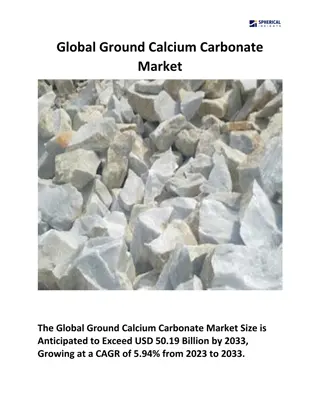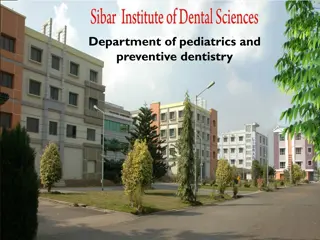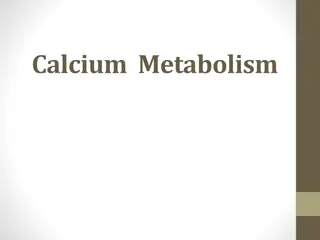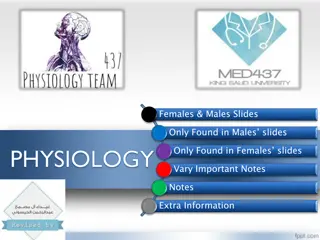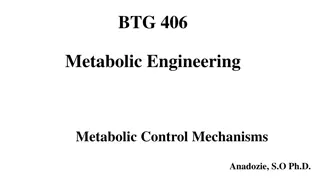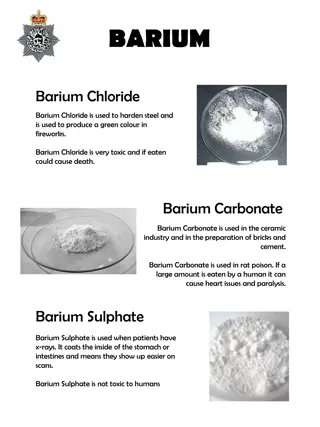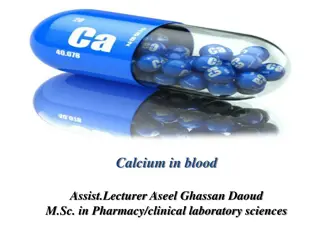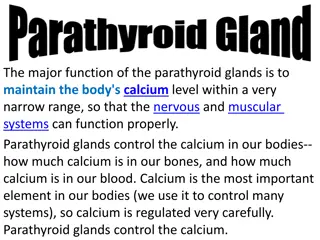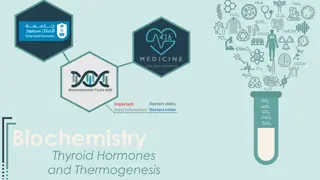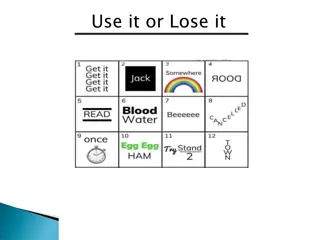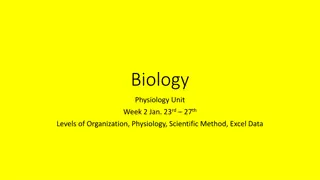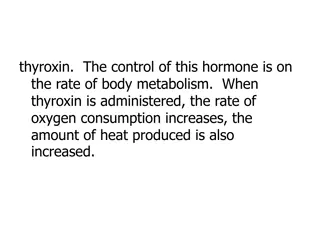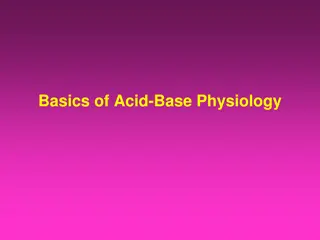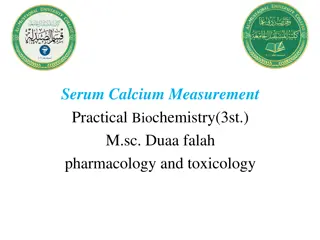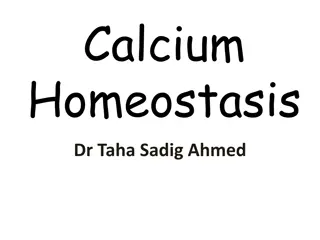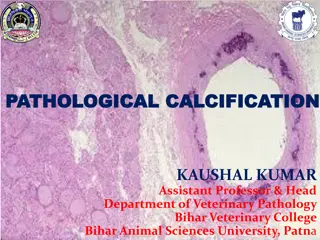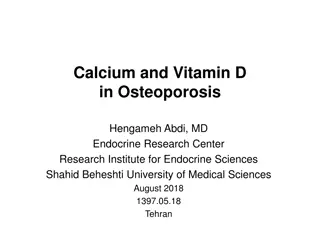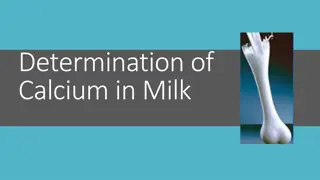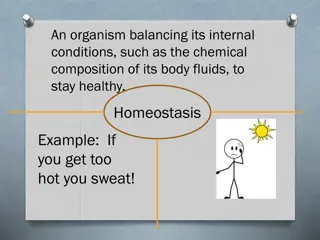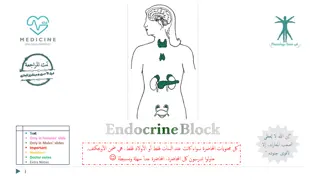Hyperparathyroidism
Hyperparathyroidism is characterized by overactive parathyroid glands leading to excessive secretion of parathyroid hormone and elevated blood calcium levels. This condition can cause symptoms like excessive urination, abdominal pain, weakness, and more. Primary hyperparathyroidism is often due to n
0 views • 20 slides
Buy Cheddar Cheese Orange Powder (500 Gm) with Rich and Tangy Flavours
Mkl & Pkd. By\n\nCheddar cheese contains a high concentration of essential nutrients, in particular high quality protein and calcium, which are great for your health. It is a good source of calcium and protein, but it can also be high in saturated fats and sodium.\n\nGourmet Delight: Cheddar Cheese
2 views • 3 slides
Diseases Associated with Homeostasis in Endocrine, Nervous, Immunological, and Genetic Levels
Exploring diseases related to disruptions in homeostasis at endocrine, nervous, immunological, and genetic levels, focusing on conditions like hormone imbalances and metabolic disorders such as growth hormone deficiency and diabetes. Learn about the impact on health and the body's intricate regulato
5 views • 38 slides
Regulation of Energy Homeostasis by AMPK System and Its Modulation Factors
The AMPK system plays a crucial role in regulating energy homeostasis by sensing the cellular AMP:ATP ratio and responding to metabolic stresses that affect ATP production or consumption. AMPK is activated by factors such as hypoxia, glucose deprivation, and metabolic inhibitors, as well as by compo
0 views • 27 slides
Global Ground Calcium Carbonate Market
\"The Global Ground Calcium Carbonate Market Size is Anticipated to Exceed USD 50.19 Billion by 2033, Growing at a CAGR of 5.94% from 2023 to 2033.\n\"\n
0 views • 5 slides
Homeostasis in Living Organisms
Homeostasis, derived from Greek meaning "standing still", is crucial for maintaining balance in living organisms. It involves regulating internal variables to prevent disease or death. Ancient Greeks emphasized the importance of harmony and equilibrium in life. Claude Bernard and Walter B. Cannon fu
2 views • 29 slides
Calcium Hydroxide in Dentistry: Properties, Classification, and Availability
Calcium hydroxide, a versatile material in dentistry, has various properties such as high solubility, low setting time, and strong alkali nature. It is classified into non-setting and setting cements used for cavity lining, root canal sealers, and more. Available in powder form and as a light-cure s
0 views • 51 slides
Calcium Metabolism: A Comprehensive Overview
Calcium metabolism plays a critical role in various bodily functions like nerve conduction, coagulation, and bone mineralization. It involves processes such as calcium absorption, distribution, and homeostasis, regulated by hormones like PTH and calcitriol. The balance of calcium in the body is cruc
7 views • 50 slides
Homeostasis: Maintaining Internal Balance in the Body
The concept of homeostasis is crucial for understanding how the body maintains a stable internal environment despite external fluctuations. This presentation covers the definitions of positive and negative feedback mechanisms, components of feedback loops, and the role of homeostatic mechanisms in p
0 views • 33 slides
Pharmacology of Drugs Used in Calcium & Vitamin D Disorders
Calcium and vitamin D play crucial roles in regulating bone health and overall calcium balance in the body. Hormones like PTH, vitamin D, and calcitonin are pivotal in maintaining calcium homeostasis. Drugs such as teriparatide, a synthetic form of PTH, are used to treat conditions like osteoporosis
0 views • 9 slides
Managing Nutritional and Metabolic Diseases in Zoo and Wild Animals
The prevention, control, and treatment of nutritional and metabolic diseases in zoo and wild animals are essential for maintaining their health. These diseases, such as rickets, osteoporosis, osteomalacia, and fibrous osteodystrophy, can result from imbalances in dietary nutrients and metabolic dera
1 views • 10 slides
Homeostasis in Humans: The Key to Maintaining Internal Balance
Homeostasis refers to the body's ability to regulate and maintain a constant internal environment despite external changes. In humans, the tissue fluid plays a crucial role in this process, with factors like pH, water concentration, oxygen levels, temperature, and glucose content needing to be contr
0 views • 80 slides
Homeostasis in Humans and Mammals
Humans and mammals rely on homeostasis to maintain a constant internal environment for survival. This involves regulating core body temperature, blood glucose levels, and water levels through nervous and hormonal responses. By understanding the principles of homeostasis, we can appreciate the vital
1 views • 22 slides
Metabolic Control Mechanisms in Cellular Regulation
Metabolic control mechanisms play a crucial role in maintaining homeostasis within cells by regulating metabolic pathways. This involves finely adjusting the output of pathways in response to external signals, ensuring the proper flux of metabolites to meet cellular needs. Pacemaker enzymes, such as
2 views • 17 slides
Cell Membrane: Maintaining Homeostasis in Cells
Cells maintain homeostasis to function effectively. The cell membrane plays a crucial role in this process by regulating material exchange, separating the cell from its environment, and ensuring internal balance. Understanding how cells exchange materials through the membrane is key to comprehending
1 views • 16 slides
Vitamin D: Clinical Relevance and Laboratory Measurement
This presentation delves into the clinical importance and laboratory measurement of Vitamin D, covering topics such as its formation, metabolism, forms, functions, deficiency causes, and typical biochemistry. It explores the impact of different genetic variants of Vitamin D binding protein, the role
1 views • 21 slides
Chemical Compounds Overview: Barium, Calcium, Sodium, Lithium
Learn about the uses and potential dangers of Barium Chloride, Barium Carbonate, Barium Sulphate, Calcium Chloride, Calcium Carbonate, Calcium Sulphate, Sodium Chloride, Sodium Carbonate, Sodium Sulphate, Lithium Chloride, Lithium Carbonate, and Lithium Sulphate in various industries and application
0 views • 4 slides
Calcium Levels in the Body: Importance, Factors, and Testing
Explore the significance of calcium levels in the body, factors influencing them, conditions like hypocalcemia and hypercalcemia, symptoms, why calcium tests are done, and the role of calcium supplements. Learn about the impact on overall health and the importance of maintaining balanced calcium lev
5 views • 17 slides
Parathyroid Glands and Calcium Regulation
Parathyroid glands play a crucial role in maintaining the body's calcium levels within a narrow range to support the proper functioning of the nervous and muscular systems. Parathyroid hormone (PTH) regulates calcium concentration in the blood, impacting bone health and other physiological functions
4 views • 18 slides
Quantitative Estimation of Metal Ions in a Mixture
Dr. Saadia Rashid Tariq explains the quantitative estimation of copper(II), calcium(II), and chloride in a mixture. The process involves iodometric titration for copper(II), complexometric titration for calcium(II), and gravimetric estimation for chloride. Detailed procedures, reactions, requirement
2 views • 8 slides
Glucose Homeostasis in Metabolic Processes
Glucose homeostasis is crucial for controlling glucose metabolism and maintaining normal blood glucose levels in the body. It involves various metabolic sources, including dietary intake and gluconeogenesis. The liver plays a vital role in regulating blood glucose levels, while severe hypo- and hype
0 views • 17 slides
Techno-Economic Analysis of Calcium Looping Processes for Low CO2 Emission Cement Plants
This study explores the application of Calcium Looping (CaL) processes in cement plants to reduce CO2 emissions. The process involves using CaO as a sorbent to capture CO2 from flue gas, with the potential for integration at different points in the cement production process. The Tail-end CaL configu
3 views • 14 slides
Homeostasis in Organisms
Homeostasis is the key to maintaining internal stability in living organisms, ensuring they return to a stable state after fluctuations. This involves various body parts such as the kidneys, skin, liver, and pancreas. Different systems like body temperature regulation, blood pressure control, and os
1 views • 51 slides
Cell Transport and Homeostasis in Biology
Delve into the world of cell transport and homeostasis, exploring the functions of the cell membrane, the molecules involved, the fluid mosaic model, and passive transport mechanisms like diffusion, osmosis, and facilitated diffusion. Learn about the intricacies of maintaining equilibrium within cel
0 views • 10 slides
The Importance of the Immune System for Homeostasis
Explore the intricate workings of the immune system, from its component parts and defense mechanisms to the significance of homeostasis maintenance. Discover how non-specific and specific immune responses, phagocytosis, neutrophils, natural killer cells, and interferons play vital roles in protectin
0 views • 32 slides
The Importance of Calcium for Bone Health
Adequate calcium consumption is crucial for maintaining healthy bones, teeth, and overall body function. Failure to achieve peak bone mass in adulthood could lead to conditions like osteoporosis. Calcium-rich foods like dairy products, dark green leafy vegetables, and fortified foods play a vital ro
0 views • 18 slides
Body Systems and Homeostasis in Physiology
Explore the levels of organization in biology, physiological systems, scientific methods, and data analysis in this week's unit. Delve into the concept of homeostasis, how body systems interact to maintain balance, and the key functions of various organ systems. Understand the importance of homeosta
0 views • 55 slides
Thyroxin and Functions of Thyroid Gland
Thyroxin hormone plays a crucial role in regulating body metabolism. Administration of thyroxin boosts oxygen consumption and heat production. The thyroid gland's functions include managing production of thyroxin, leading to hyperthyroidism or hypothyroidism. Disorders such as cretinism and myxedema
0 views • 102 slides
Importance of Calcium and Phosphorus in Animal Nutrition
Calcium and phosphorus are crucial minerals for animal health, with calcium being the most abundant mineral in the body. They play essential roles in nerve impulse transmission, muscle contraction, and bone structure. Deficiencies in these minerals can lead to conditions like rickets, osteomalacia,
0 views • 11 slides
Acid-Base Physiology in the Human Body
Acid-Base homeostasis plays a crucial role in maintaining the optimal acidity of body fluids through a balance of chemical buffers and physiological processes. Disruptions in this balance can lead to various effects on the central nervous system and ionized calcium levels. Understanding the concepts
0 views • 21 slides
The Importance of Dairy Products for Your Health
Dairy products are essential for providing nutrients like calcium, vitamin D, and protein. They help in bone and muscle health, blood clotting, and nerve function. If you are lactose intolerant, there are alternative sources to get calcium. Meeting the recommended daily allowance of calcium is cruci
0 views • 11 slides
Calcium Influence on Earthworm Behavior in Forest Ecosystems
Earthworm biomass dominance by Lumbricus terrestris in the Siemianice Experimental Forest is linked to their high calcium requirements, as indicated by their calciferous glands producing calcium carbonate to regulate blood pH in the face of high soil CO2 levels. The positive relationship between for
1 views • 8 slides
Serum Calcium Measurement in Practical Biochemistry
Calcium is a crucial mineral for various bodily functions like muscle and nerve signaling, heart health, and bone formation. Serum calcium tests help screen for bone diseases and calcium disorders by measuring the amount of calcium in the blood. Two types of tests, total calcium and ionized calcium,
0 views • 12 slides
Calcium Homeostasis and Its Importance in the Body
Calcium homeostasis plays a crucial role in various physiological functions, including bone integrity, blood clotting, enzymatic regulation, hormonal secretion, neurotransmitter release, nerve excitability, and muscle contraction. Bones act as a major calcium reservoir, with blood containing 50% ion
0 views • 17 slides
Pathological Calcification in Veterinary Pathology
Pathological calcification is the abnormal deposition of calcium salts in soft tissues, with two forms - dystrophic and metastatic calcification. Dystrophic calcification occurs in dying tissues, while metastatic calcification reflects a derangement in calcium metabolism. Dystrophic calcification ca
0 views • 11 slides
Update on Calcium and Vitamin D Supplementation in Osteoporosis
The study reviews the benefits and risks of calcium and vitamin D supplementation for bone health. It discusses the impact on bone loss, fracture prevention, fall prevention, and cardiovascular risks. Evidence suggests that increasing calcium intake may have limited effects on bone mineral density a
0 views • 30 slides
Importance of Calcium in Milk for Bone Health
Calcium is a crucial mineral essential for maintaining strong bones and teeth, muscle function, and blood circulation. This article discusses the significance of calcium, recommended daily intakes, sources of calcium in milk, and a complexometric titration method for determining calcium levels. Milk
0 views • 10 slides
Biological Responses: Homeostasis, Stimuli, and Feedback Mechanisms
Explore the concepts of homeostasis, stimuli, and feedback mechanisms in biological systems. Learn how organisms maintain internal balance, respond to internal and external stimuli, and regulate bodily functions through feedback processes. Discover examples of responses such as sweating when hot, sq
0 views • 10 slides
Preparation of Calcium Peroxide (CaO2) in Inorganic Chemistry Practical II
This practical experiment details the preparation of calcium peroxide, a solid peroxide used in various industries and agriculture. The procedure involves the reaction of calcium salt and sodium peroxide to synthesize calcium peroxide, which has applications in agriculture, aquaculture, ecological r
0 views • 7 slides
Parathyroid Disorders - Calcium Metabolism and Hormonal Regulation
This presentation covers the functions of calcium, calcium metabolism, bone physiology, and hormonal regulation of calcium metabolism focusing on parathyroid hormone, calcitonin, and Vitamin D. It discusses hypo and hyperparathyroidism in detail, including clinical manifestations and treatment optio
0 views • 15 slides




